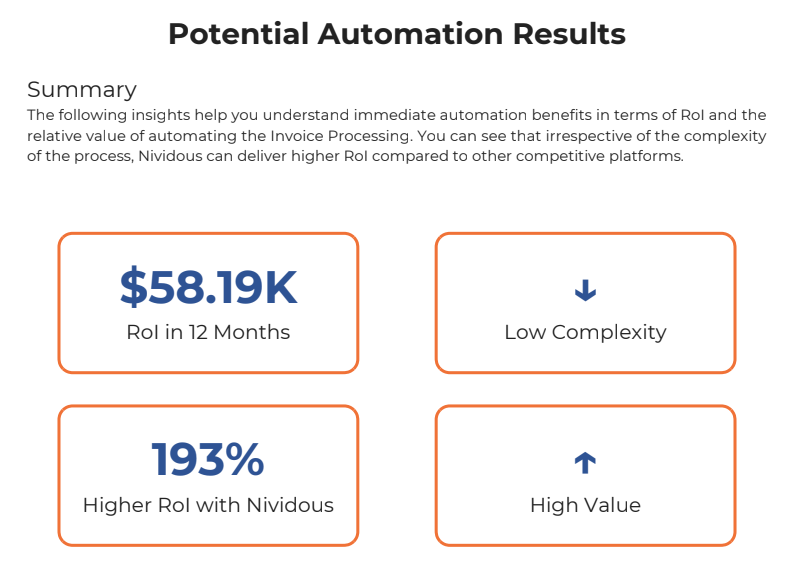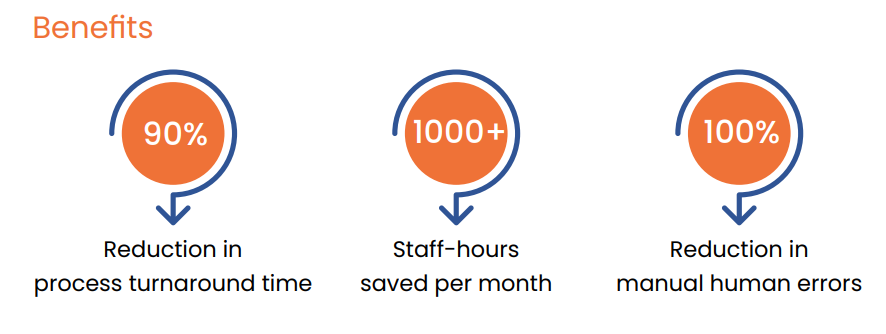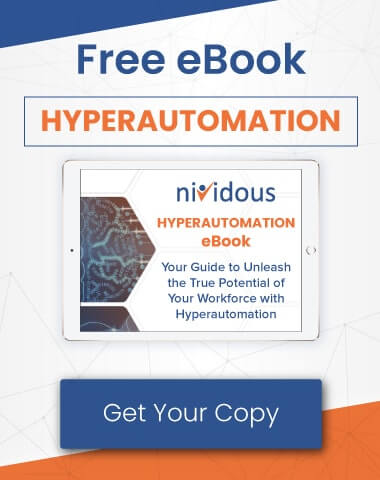A growing number of industry leaders are taking steps, though cautiously, toward transforming their businesses through digital technologies. They know the future is digital, and the first movers can lead with an advantage. But, digital transformation, a collective change towards how companies operate, has a broad scope of applicability and often poses various challenges for leaders, including determining the right course of action. This article guides you in learning what digital transformation means in its real sense and how a 5-step roadmap can help you begin your transformation journey on the right foot.
What is Digital Transformation?Digital transformation is a quick way to describe the use of technology to complete business operations more efficiently. Not long ago, that involved simply transitioning from paper documents to digital files. Today, advances in artificial intelligence and network connectivity place the focus on automation—including intelligent automation for end-to-end processes. Digital Transformation initiatives not only help you in creating and modifying business processes but also enable you to transform the culture. These initiatives also help you to elevate customer experiences to a large extent. Three Fundamental Elements of Digital transformationDigital transformation initiatives with these elements deliver enterprise-grade impact. Digital infrastructure refers to the buildout of an organization’s data processing, storage, communication, and computing abilities in a digital world. It includes everything from new hardware and software to secure online systems. Digital operations focus on using technology to streamline processes such as sales, marketing, service, manufacturing, and supply chain management. They encompass everything from improving customer interactions through automation tools to reducing the time needed for tasks such as order fulfillment. Customer experience encompasses everything from how customers find information about products and services to how they are billed for those products or services. |
Digital transformation is about becoming more digital-focused and ensuring a smooth and effective transition while making this change. Let’s jump to the five-step digital transformation roadmap and its guiding principles to understand this transition in more detail.
A 5-Step Digital Transformation Roadmap
1. Identify a clear objective.
Every digital technology project should address a specific goal. This goal can be broad—increasing revenue by a set percentage, hitting a cost-cutting target, or improving a team’s output efficiency by a certain amount. Or the goal can be granular. For example, one Nividous client—a major manufacturer of mineral products—wanted to reduce turnaround time and errors in accounts payable processes (we’ll get to the solution and results of this example in later steps).
The more specific you make your goal, the easier it will be to determine success. Remember, a digital transformation strategy isn’t associated with any one technology; you may try several solutions before meeting the goal. But you need a goal to even begin.
Guiding Principle – Defining Value & Securing Stakeholders’ Commitment
Making your senior management aware of the desired value is as important as defining the value or setting clear objectives for your digital transformation initiatives. The clarity of the magnitude of the undertaking and its communication makes it easier to secure a commitment from relevant stakeholders. Then the leaders’ job is to take accountability and communicate well (in both directions) with the ground-level teams. The chances of succeeding at digital transformation initiatives are higher when leaders own the projects end-to-end.
2. Measure the potential effectiveness of several technology solutions against your goal.
Reach out to technology vendors to learn how their products may meet your goal. Set qualitative and quantitative benchmarks, and use tech demos to estimate whether each solution you’re considering can meet them. The simplest Key Performance Indicator (KPI) to test is Return on Investment (RoI). Vendors should be able to provide RoI estimates; ask them.
Guiding Principle – Safeguarding Investment
Securing investment is also critical; management should be willing to allocate investment to improve current processes and build new business models. Some investments may produce lower profits for a while—but without it, there is a risk of forgoing higher returns in the longer term.
At Nividous, we offer a free RoI Calculator for our intelligent automation platform. Simply enter as-is process data for a detailed estimate of how you’ll save with digital automation. The report provides both monthly and quarterly RoI estimates, as well as comparisons with other automation platforms. It even includes a complexity vs. value matrix that will help you choose which processes are best primed for end-to-end automation.

Of course, this is preliminary research; you can’t be sure how any technology will function until you try it out. That’s the next step.
3. Run a small-scale pilot program with your chosen solution.
Once you’ve identified a promising technology, confirm its effectiveness with a pilot program. Choose one task or process that relates to your overall goal, and implement the technology on a small scale. Collect data rigorously. Not only does a pilot study confirm assumptions about a solution’s helpfulness, it builds a business case you can take to fellow stakeholders for buy-in on broad-scale implementation.
Nividous makes it easy to run a risk-free pilot study through our Quick Start Guarantee. This program allows you to fully implement a single digital process automation within just three to four weeks, all with a fixed cost and ongoing professional services to continue your digital transformation initiatives.
Guiding Principle – Building Teams and Initiating Cultural Change
Building a digital team with the skill set to address the ongoing digital transformation initiatives at every level of the business is crucial. You may want to recruit new individual talent or hire an agency or train your existing workforce with required skills depending upon your digital initiatives. How companies organize their teams – let’s say setting up a unit independently of the organization – can promote the importance of digital transformation initiatives. Thoughtful work-culture changes are essential for smooth operations and the success of digital transformation initiatives.
4. Scale the technology to its maximum effective reach.
Once the pilot program delivers results, it’s time to get the most value out of the technology. Implement the technology throughout your targeted workflows. For instance, remember the manufacturer we introduced in Step 1? The goal was to reduce turnaround time for invoice processing. Once the team determined the Nividous platform could deliver, they used its AI-powered Robotic Process Automation (RPA) bots to automate invoice data transfer from invoices into a central Enterprise Resource Planning (ERP) system—and the platform’s automated reporting system quickly showed results.
Guiding Principle – Company-Wide Operational Change
The end goal of a digital transformation initiative is to operate with higher efficiency, leading with a competitive edge and driving higher profits. All of these require companies to establish a company-wide operating model that is not siloed but holistic, agile, and well-connected. It is essential to scale your digital transformation initiatives across the enterprise while continually building new capabilities and nurturing teams. That brings us to the final step in our digital transformation roadmap.
5. Evaluate success continually.
New technologies arrive every day. To remain competitive, you need to recognize when your current digital infrastructure is falling behind. The key to staying current is to consistently evaluate existing tools through data-rich reporting. The Nividous hyperautomation platform captures this data automatically, helping users turn information into insight with integrated reports.
That’s how the manufacturer in our example saw that Nividous was meeting the objectives. In fact, by automating invoice processing, the company reduced task turnaround time by 90%, saved more than 1,000 staff-hours per month, and eliminated manual errors entirely.

Digital transformation examples
As a global intelligent automation company with over 25 years at the forefront of digital process automation technology, we have several success stories to share. Here are a few digital transformation examples across industries to help you gauge its impact and guide you to pursue it at your company.
Example 1
A leading stock brokerage company identified franchise onboarding as the first process to automate with the Nividous intelligent automation platform and began its digital transformation journey. After reducing human efforts by 90%, errors by 85%, and process handling time by 65%, the customer expanded the scope of automation to other tasks involved in the franchisee onboarding automating the complete process end-to-end. Read this detailed blog to learn what digital transformation in banking means in practice.
Curious about how Credit Unions and Banks can utilize digital transformation?
Discover relevant success stories and solutions to take reference from for starting your digital transformation journey
Example 2
An accounting and finance team of a leading manufacturing company successfully transformed its manual accounts payable process with a Nividous intelligent automation platform achieving over 85% improvement in process efficiency. According to the company’s Director, “An automated approval process has allowed us to achieve straight-through processing while reducing human errors by 90% and achieving data extraction accuracy by 98%. Most importantly, we can effectively orchestrate work between Bots and our employees with the Nividous platform’s native BPM – workflow management, RPA, and AI capabilities.” AP automation is just the starting point. The customer plans to scale the use of automation to several other areas where there is considerable scope for improvement in operational efficiency.
Example 3
AEG Vision, a leading eyecare provider and a winner of the ‘Best Achievement in Process Automation’ award at the BTOES 2021 awards, revolutionized its revenue cycle management by leveraging a combination of RPA, AI, and workflow automation technologies. This customer partnered with Nividous to introduce an automation-led digital transformation in every facet of its business and achieved a whopping $4M ROI in just 12 months. The Nividous intelligent automation platform helped the customer to improve cash flow, customer experience, and ease of integration to support business growth. Automating core business processes helped the customer save 250K man-hours and improved the claim processing cycle’s efficiency by 80%.
Are you interested in achieving similar results?
Follow the steps in this digital transformation roadmap and reach out to Nividous to learn how intelligent automation can help.
Drive Your Digital Transformation with Nividous
Nividous, with its holistic approach to leveraging automation technologies, helps you achieve your digital transformation goals with the lowest total cost of ownership and highest ROI. Nividous’ intelligent automation platform – a unified platform designed to solve complex business challenges with ease – helps you automate any business process in any environment making change management as minimum as possible. From choosing your first process automation project, implementing the first bot into production with a low-cost, no-risk offer, scaling it to various departments and business functions, to building a center of excellence, Nividous does it all. Set up your free consultation with Nividous today.






